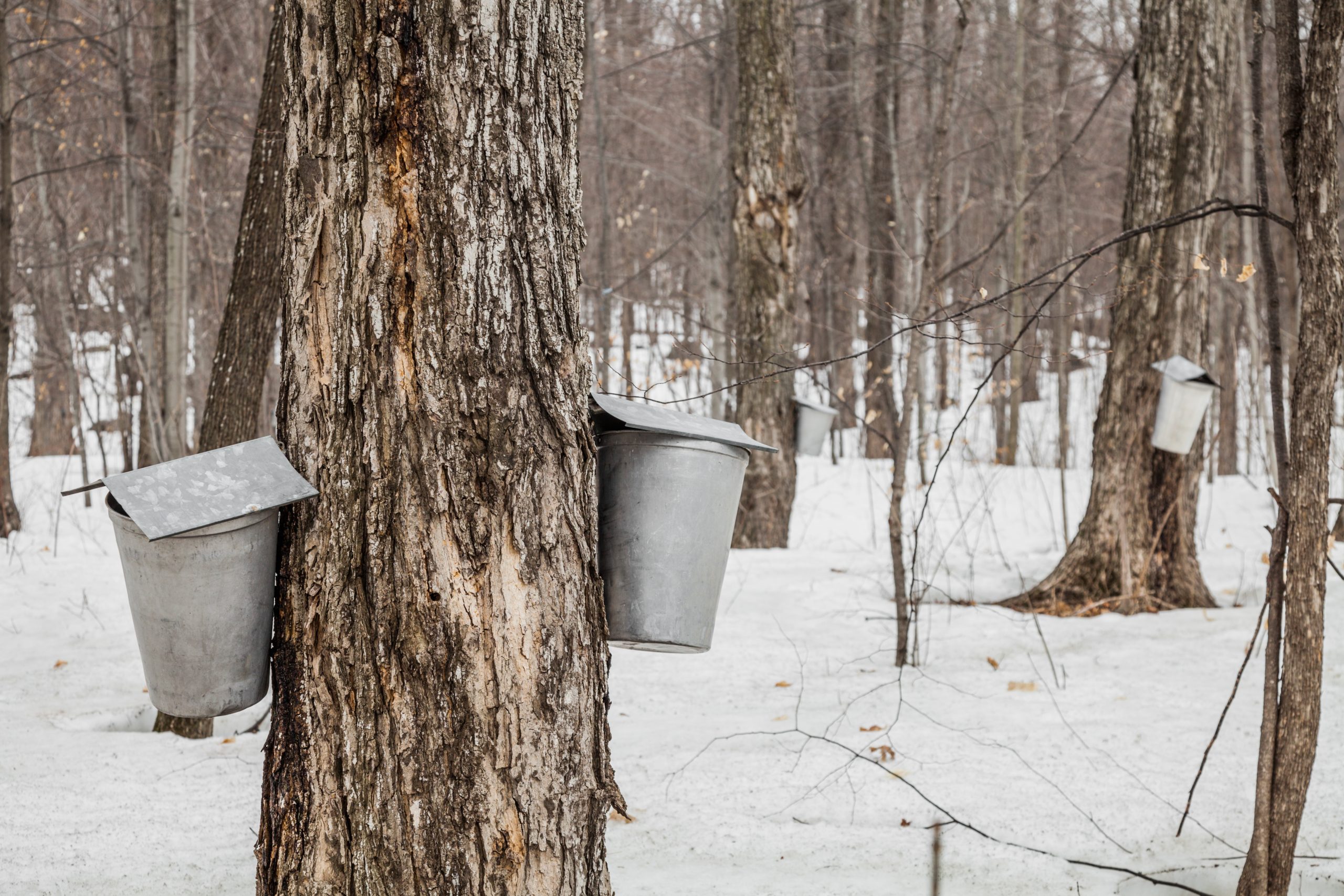
19 Aug Did you know?
– Québec exports its maple products to over 50 countries.
– Scientists are studying all of maple’s potential health benefits.
– Maple syrup can be used as a sugar substitute in most recipes.
Winter
FROM DECEMBER 21ST TO MARCH 20TH
The sugar bush is under snow and nature seems asleep. The creek and the little pond are frozen. Deers scrape at the snow with their hoofs to find food. A fox walks lightly on the snow. Black-capped chickadees flit from branch to branch. Time passes slowly until winter ends and the maple producer pulls on snowshoes and goes out to make notches in the sugar maples once again.
The Ecosystem, the Fauna, the Flora
Did you know that a sugar bush is an actual ecosystem? Its trees and plants absorb light and water (in a process called photosynthesis) and release the oxygen that the whole world and everything living in it need. That’s pretty impressive!
The sun makes the sugar maplesDID YOU KNOW?North America has 13 maple tree species, including the sugar maple.View All ’ roots grow, while rain waters the flowers, plants, and trees of the maple forest. Animals, birds and insects feed on these plants and, in turn, some of them are food for other animals, birds and insects. This is the circle of life…
The Sugar Bush…Environmentally Friendly!
The trees of the sugar bushDID YOU KNOW?The sugar maple tree has existed in North America for more than 4,500 years.View All have their own story. They serve as home and nourishment for the flora and fauna. They are born; they grow; and they die. They’re then used to heat the evaporator in the sugar shack, or to make toys and furniture, or even to build houses.
You’ll find a large variety of treesDID YOU KNOW?The sugar maple and red maple are two tree species with the ability to convert starch to sugar.View All , flowers, plants, animals, insects, and birds in the sugar bush. Underground, moles and insects are at work decomposing the humus. In the underbrush, there are wood frogs, red-backed salamanders, mice, chipmunks, hares, partridges, raccoons, skunks, foxes, coyotes, bears, and deers. Look up in the trees, and you’ll see many kinds of insects, woodpeckers such as the Northern flicker, black-capped chickadees, wood thrushes, owls like the Eagle owl, squirrels, and porcupines. The sugar bush is full of life!
Furthermore, the maple forestDID YOU KNOW?Each year, maple forests capture an amount of carbon equivalent to what’s produced by 290,000 cars.View All is home to a wide variety of plants and flowers, some of which are quite rare and in need of protection, such as the ramp (wild garlic), ginseng, and the trillium. Put all together, it’s like a beautiful garden. And it smells so good!
THE HISTORY OF MAPLE SYRUP
According to Brother Marie-Victorin Kirouac, the celebrated botanist who founded the Botanical Garden of Montreal, an old First Nations legend traced the discovery of maple sap to seeing a squirrel full of energy after drinking it from a tree. That’s quite a story!
Since First Nations peoples passed on their knowledge orally, there is no written confirmation of when or how maple sap was really discovered. One thing is certain: it happened centuries ago…
Jacques Cartier discovered Canada but did you know he was also the first European to write about the sugar maple and maple sap? It happened as early as 1557 and quite by chance during one of his voyages to Canada. Cartier cut a tree from which, to his astonishment, flowed a sweet-tasting sap. The First Nations inhabitants told him they called the magical tree “couton”. Today, we know it as the sugar maple.
The Invention of Maple Syrup
For a long time, the new inhabitants of Canada consumed maple sap in sugar form, making it into candies and other things. Until 1850, production techniques didn’t change much: for instance, they made cuts in the trees with an ax! Little by little, methods advanced with the invention of the sap spout and building of sugar shacks. Books tell us that meals were first served in Quebec sugar shacks in 1861.
Maple syrup didn’t make its first appearance until the 20th Century, but preserving it remained a problem. Finally, in the 1920s and 1930s, it was found to keep well in cans and jars, that is, by canning it. For those with a sweet toothDID YOU KNOW?Quebec produces over 72% of all the maple syrup in the world.View All , it was a turning point in history!
Health and Sports
The First Nations people of eastern North America have long known about maple sap, and drank it for its fortifying qualities. They also boiled the bark of various maple species for the treatment of wounds, abscesses, and eye ailments. As you can see, the health benefits of maple have been known since the dawn of time!
The First Nations people later revealed these energizing virtues to the famous coureurs des bois. These travelling woodsmen, on their long voyages in the wilderness, drank maple bark tea and ate bannock, the native bread made of corn flour and maple sugar. It packed easily and was a handy source of quick energy for men on the move.
We now know that the First Nations and coureurs des bois were absolutely correct! Maple is a very special sugar that contains plenty of vitamins and minerals such as manganese, riboflavin, zinc, magnesium, potassium, and calcium (so important to growing bones). Researchers at Université Laval in Québec City have even recently discovered that maple syrup contains tiny agents, called antioxidants, that may protect against heart disease, diabetes, and other health problems. In fact, maple syrup holds five times more of these elements than honey.
Maple Syrup, the Choice of Champions!
Did you know that many Quebec athletes, like cyclists Simone Boilard and Hugo Houle, count on maple syrup for better performance? It’s a fact that consuming maple syrupDID YOU KNOW?Maple syrup from Quebec is pure and 100% natural.View All before, during, or after sport or exercise provides the carbohydrates (namely, sugar) that the body needs to maintain a good level of energy.
Clearly, maple syrup has its place in a healthy diet. It’s important, however, to consume it in moderation because, while it’s a “good” sugar, it’s still sugar!
The Sap Flows
In springtime, usually the month of March when it’s cold at night and warm during the day, the sap of the sugar maple tree begins to flow.
The Sap is Collected
The maple sap is collected in buckets or a tubing system, and sent to the sugar shack.
Evaporation
The collected sap is put in a large receptacle called an evaporator to be boiled until it becomes delicious maple syrup. It takes an average of 40 litres of maple sap to make just one litre of maple syrup.
Processing
Maple sap can be turned into dozens of different maple products, such as syrup, water, butter, flakes, sugar, and block sugar. They’re all made of pure, 100% natural maple.
Enjoyment
The only thing left to do is enjoy some maple! Did you know that 95% of Quebeckers consume maple syrup more than once a week?
Maple syrup tastes great, but that’s not all. Over the past few years, scientists around the world have conducted extensive research on maple. That’s how we now know that maple syrup contains more than 100 nutrients, includiing several vitamins and minerals that are good for you. Scientific experiments have even proven that maple syrup has a super antioxidant capability comparable to that of brocoli. These are juste some of the secret benefits hidden in every little drop of maple syrup.
Inulin
Maple syrup also contains inulin, which belongs to the prebiotic family. It feeds the good bacteria (the kind you want) that live in your tummy and fight the bad bacterias.
Carbohydrates
Maple syrup is a source of energy, the fuel that makes your body work. So, if you didn’t get the fuel you need for energy, you wouldn’t be able to play your favorite game or sport!
Quebecol
Maple syrup contains 67 antioxidants compounds, including the molecule Quebecol… named, of course, on honor of Quebec! Tomatoes and brocoli are foods rich in antioxidants, little secret agents that protect your body from heart disease, diabetes, and other health problems. They’re great friends to have!
Calcium
Maple syrup is a source of calcium, an essential mineral that helps your teeth and bones grow and stay healthy. Without it, just a small bump could cause you a broken bone and your visits to the dentist would be even less fun.
Magnesium
Maple syrup is a source of magnesium, another essential mineral that teams up with calcium to keep your bones healthy. Scientist even tell us that magnesium helps your muscles recover after physical exercise.



